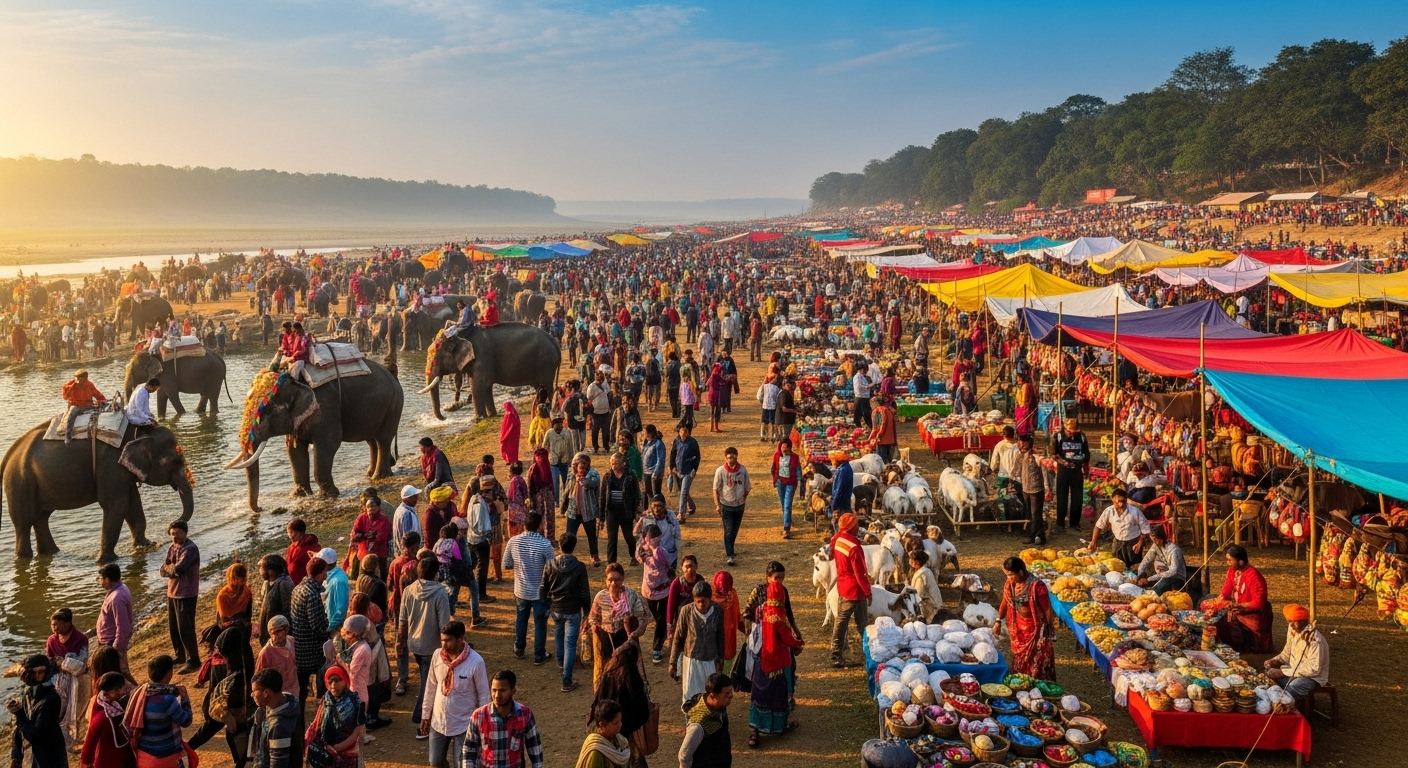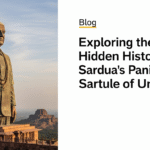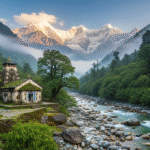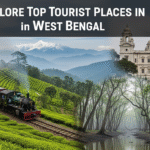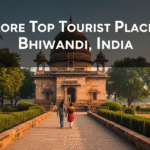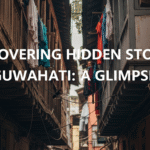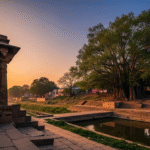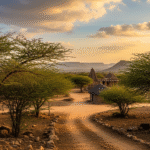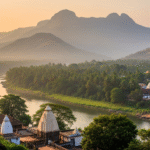Every year, many people visit the famous Sonepur Mela. But, few know about its secret stories. These stories add color to the fair’s rich history. They help us see the event in a new light.
In looking for these secrets, we find more than just fun activities. We uncover stories passed down for generations. These stories show the fair is not just about buying and selling. It’s a celebration of history and human connections.
Key Takeaways
- Understanding the intricate history behind Sonepur Mela.
- Revealing the cultural complexities that enrich this annual gathering.
- Focusing on the economic nuances that Sonepur Mela injects into the local community.
- Glimpsing into the religious practices that underscore the festival’s significance.
- Appreciating the Mela’s role in preserving and passing down cultural traditions.
Are you curious about food, culture, and community in Patna? The Boring Cafe shows this mix well. It offers tasty dishes that reflect the fair’s diverse tastes and stories.
The Historical Significance of Sonepur Mela
The Sonepur Mela is a big event near the Ganges River. It brings people together for buying and selling and sharing their culture. This fair is very old and is important in the history and myths of Bihar and India.
Origins Dating Back to Ancient Times
The Sonepur Mela started a long time ago during the time of Chandragupta Maurya. It is one of the oldest fairs in India. People used to buy and sell elephants and horses which helped the Mauryan army.
Connection with Mythological Events
Mythology is a big part of the Sonepur Mela. It is based on a story where Lord Vishnu stopped a fight between an elephant and a crocodile. This shows the fair’s divine start and protection.
Royal Legacies and Patronage
Many kings have supported the Sonepur Mela, making it very special. They came to buy elephants and horses and show their power. This support made the fair an important cultural and social event.
The Sonepur Mela is a colorful mix of history, myths, and royal stories. It attracts people from all over the world. The fair shows how old traditions and stories are still alive in India today.
Sonepur Mela’s Transformation Over the Years
The Sonepur Mela was once a small fair. Now, it’s a global phenomenon. People from all over come to see it. This Sonepur Mela transformation shows that old cultural events can grow. They can keep their heart but still become modern.
From a Local Fair to a Global Phenomenon
The Sonepur Mela started small but grew big. Now, it gets visitors from around the world. This jump from local to global made the Mela famous. It shows India’s culture can charm the world. Its elephant and livestock markets entertain people globally. This makes it a top spot to visit.
Changes in Traditions and Practices
The Mela has changed a lot as it grew. Changing traditions can be seen in what it offers. From animal markets to fun rides, craft markets, and digital payments. Sonepur Mela mixes old and new. This mix helps keep the fair interesting but still true to its roots.
Impact of Modernization on the Mela
Modern changes at Sonepur Mela affect many things. Modernization impact means better services and more people coming. But, the fair’s heart — its culture — stays the same. This balance helps the Mela stay loved and relevant.
Changing into a global event while valuing its origins is tricky. But Sonepur Mela does it well. It shows how old events can grow and stay real for new fans. It keeps its soul but embraces new ways.
Unique Cultural Expressions at Sonepur Mela
The Sonepur Mela is more than a big animal fair. It’s a display of rich culture. Every year, thousands come to see the cultural beauty in it. This fair is part of history.
It shines with folk dances, plays, and music. These show Sonepur’s culture and its stories. Under the sky, people share tales. This lights up Bihar’s heritage.
Many stalls have handloom weaves, showing Bihar’s silk talent. These beautiful items show visitor’s the local craft. They highlight the area’s culture.
The fair happens near the River Ganges. This spot is special, blending culture and spirituality. It’s a place for trade, cultural talks, and renewal.
Walking through the fair teaches about heritage. Everything at the fair helps keep Bihar’s culture alive. Each buy and look keeps the tradition going.
So, the Sonepur Mela does a lot more than trade animals. It keeps Bihar’s culture vibrant. This fair is a treasure of Indian culture. It teaches, inspires, and brings joy.
The Livestock Fair: A Core Aspect of Sonepur Mela
The Sonepur Mela includes a lively livestock fair. It’s a place full of culture and business that brings in people and traders. The Elephant Bazaar is at its heart. It shows off the big beauty of these animals. The fair keeps up old cattle trade customs. It also shows how important different animals are to the area’s culture.
The Elephant Bazaar: A Rare Spectacle
The Elephant Bazaar at Sonepur Mela is where people come to buy and sell elephants. It draws experts and animal lovers. Seeing these elephants in Sonepur is special and reminds us of old traditions. These traditions saw such trades as noble and important.
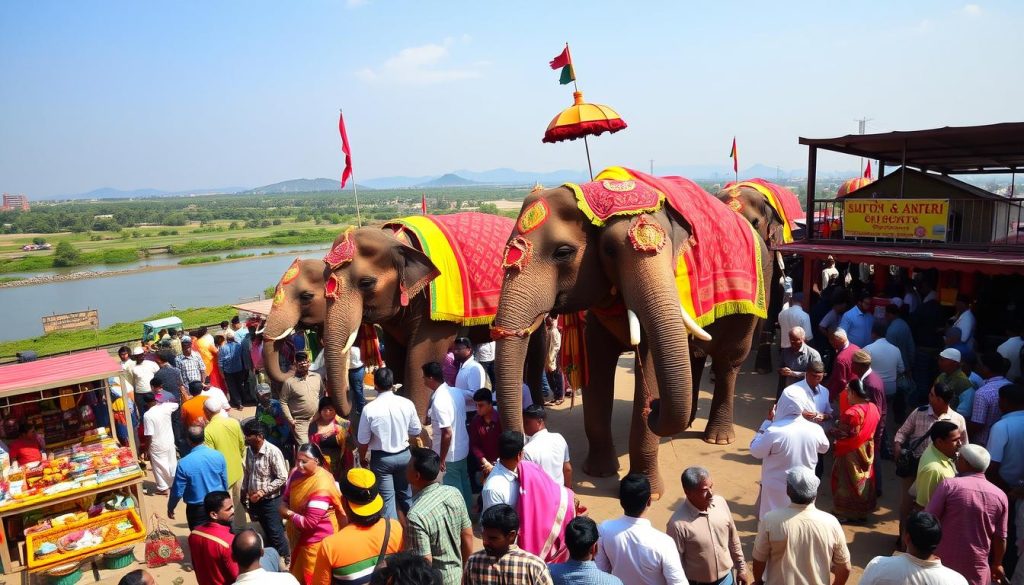
Cattle Trades and Historical Practices
For a long time, Sonepur Mela’s cattle trades have supported the area’s farming and economy. These traditions pass down through families. They show deep knowledge of taking care of animals, key for the local economy. Farmers and traders swap animals and share tips and stories. This keeps their heritage alive.
Diverse Animal Presence and Significance
The fair has more than just elephants and cows. You can see horses, goats, birds, and even fish. Each animal is special in its own way. Their importance is shown and celebrated. This makes the fair a rich mix of animal life. It shows the beauty and practice of keeping different animals.
The Sonepur Mela’s livestock fair is full of culture and business. It highlights the Elephant Bazaar as an important site. But it also shows the fair as a lively place where old and new mix. It makes people and visitors from everywhere enjoy the animals and the trades.
Sonepur Mela’s Economic and Commercial Impact
The Sonepur Mela is a big festival. It’s known for its economic impact and commercial significance. Millions of people visit from all over the world. This helps the local economy grow thanks to tourism, trade, and hospitality.
In the past, trading elephants was a big deal at the fair. Elephants were used for many things like transportation and ceremonies. This shows their value. Now, the way elephants are traded has changed. But, the fair’s economic role is still important. Today, elephants are more about culture than trade at the Mela.
Nowadays, lots of brands come to the Sonepur Mela. They set up booths to reach many people. For example, Volini and Dabur Chyawanprash offer health products. They want to build loyalty by talking to customers directly at the fair.
| Brand | Activity | Impact |
|---|---|---|
| Volini | Foot massage camps | Enhanced visitor comfort and brand engagement |
| Dabur Chyawanprash | Product sampling | Increased product awareness and customer loyalty |
| FDC Limited | Electral Powder distribution | Immediate relief for tired devotees, positive brand association |
Using the fair for marketing shows its commercial significance. It’s a place where local and national brands meet a diverse crowd. This mix of old commerce and new marketing shows the fair’s strong economy.
The Sonepur Mela adapts and grows by mixing old and new commerce. This keeps its culture alive while helping the economy. It’s important for economic experts and culture lovers to see.
Hidden Facts About Sonepur Mela
Sonepur Mela sits at the Ganges and Gandak Rivers’ meeting place. It’s a buzzing cultural hub. It holds many stories and details about its daily life. This fair is important in Bihar’s history and famous worldwide.
Untold Stories from the Locals
Sonepur locals have watched the Mela change over time. They share stories about its start and changes. Stories involve famous people and big trades. These tales add a personal touch to the Mela’s long history.
Insider Information on the Mela’s Operations
Sonepur Mela takes lots of planning and teamwork. For two weeks, the town focuses on festival events. There’s a special place for elephants to be shown off. Local leaders work hard to keep things running smoothly for everyone.
Lesser-Known Details of Day-to-Day Activities
Every day at the Mela is unique. It shows off animals, crafts, and has spiritual events. People come to bathe at the river meeting spot during a special festival. Trading animals and birds involves special rituals and talks.
The Bihar community works hard to keep the Mela lively. It’s an important cultural and spiritual event in India.
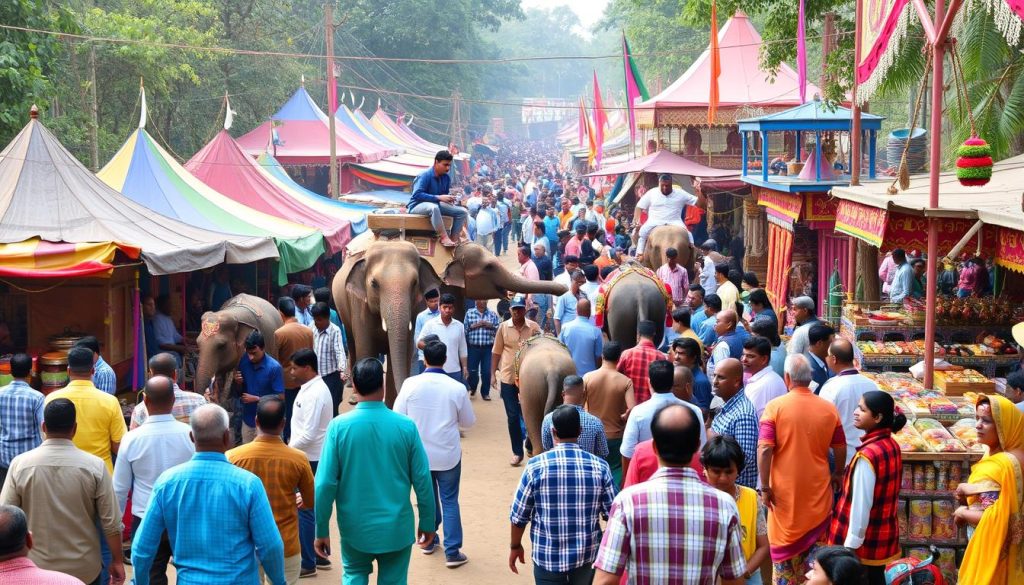
Comparing Sonepur Mela to other big fairs shows its special place. It’s big in cultural tourism:
| Fair | Location | Unique Feature | Visitor Count |
|---|---|---|---|
| Sonepur Cattle Fair | Bihar | Elephant auction and river confluence | Millions annually |
| Pushkar Fair | Rajasthan | Largest camel fair | Over 200,000 |
| Kolayat Fair | Bikaner, Rajasthan | Major cattle trading hub | N/A |
| Hemis Gompa Festival | Ladakh | Buddhist cultural celebrations | Thousands |
| Gangasagar Pilgrimage | West Bengal | Second-largest human gathering in India | Millions every January |
This table shows Sonepur Mela’s huge role. It stands out with elephant auctions and holy meetings on the river.
Religious Practices and Symbolism at Sonepur Mela
The Sonepur Mela is a colorful event full of religion. It brings people from everywhere to see it. The mela includes many rituals from the Hindu calendar. This makes the experience very rich for everyone who goes.
Sonepur Mela religious practices come alive with important Hindu festivals. It happens on special days like Raksha Bandhan and Sawan Somwar. These days are picked to make the festival’s spiritual feel stronger. This mix of business, culture, and spirit is very special.
Sonepur Mela symbolism shines during Raksha Bandhan. This festival is about caring and protection. It’s big at the mela and brings lots of people together. During it, a sacred thread called a rakhi is tied as a symbol of protection.
Sawan Somwar is another special time at the mela. People do rituals like Rudrabhishekam to honor Lord Shiva. This brings clarity and prosperity. These practices show the mela’s wide spiritual appeal.
| Festival | Date in 2024 | Key Rituals | Associated Symbolism |
|---|---|---|---|
| Raksha Bandhan | August 19 | Tying of Rakhi | Protection and Blessings |
| Sawan Somwar | July 22, July 29, August 5, August 12, August 19 | Rudrabhishekam, Fasting | Auspiciousness, Clarity |
The Sonepur Mela religious practices and its symbols make it more than a festival. It’s a deep experience for visitors and sees faith and business join beautifully.
The Role of Sonepur Mela in Cultural Preservation
The Sonepur Mela is a key event in India’s history. It showcases the country’s rich cultural background. The fair is not just about buying and selling animals. It’s also a living picture of rural Indian life. This event has been around since the time of Chandragupta Maurya. It shares our history and keeps it relevant today.
Protecting India’s Intangible Heritage
This event has a long history, going back to the times of kings and sacred places. It’s more than a place to buy horses and elephants. The Sonpur Mela keeps India’s rural traditions alive. Every ritual, from holy baths in the Ganga to animal trading, is special. These actions help keep our unique heritage alive.
Passing Traditions to Future Generations
The Mela is a big classroom for young people. They learn about our folklore and history here. This ensures our past’s colors aren’t lost over time. During Kartik Poornima, the fair’s biggest day, heritage is passed down. People from all over create lasting memories here.
The Fair as a Medium of Cultural Exchange
The Mela is also a meeting place for different cultures. It welcomes traders and pilgrims from all over. This fair shows how we can all celebrate together. It’s full of music, crafts, and stories from various places. These create a mix that shows the true spirit of Indian hospitality.
FAQ
What are some lesser-known details about Sonepur Mela?
Sonepur Mela is more than an animal market. It’s a place where traditional plays, folk dances, and music shine. These cultural treasures are as important as the livestock trading.
Can you shed light on the historical significance of Sonepur Mela?
The fair’s history dates back to the Mauryan Empire. It’s also tied to the Ramayana tale. Here, a celestial being turned elephant was captured, adding to its mythic charm.
How has Sonepur Mela transformed from a local event to a global attraction?
Sonepur Mela has become a global destination. It welcomes tourists and media from around the world. This shift celebrates India’s traditions on a world stage, thanks to technology and cultural sharing.
What unique cultural expressions can be found at Sonepur Mela?
The fair is a treasure trove of culture. Visitors can see Madhubani art, listen to Bhojpuri tunes, and admire local crafts. These highlight Bihar’s rich traditions and skills.
What is the significance of the Elephant Bazaar at Sonepur Mela?
The Elephant Bazaar is special. It’s rare to see such trading today. Royals and common folks once marveled at this, making it a highlight of the fair.
How does Sonepur Mela contribute to the local economy?
The fair boosts the economy majorly. It helps with livestock, crafts, and food sales. This event is key to the area’s financial health and growth.
Are there any untold stories from the locals about Sonepur Mela?
Locals share stories of community, traditions, and opportunities. These tales give a peek into rural life and the fair’s deep community ties.
What religious practices and symbolism are associated with Sonepur Mela?
The fair is spiritually rich. People visit the Hariharnath Temple and bathe in the Ganga. These acts reflect deep beliefs and the mela’s sacred side.
In what ways does Sonepur Mela act as a medium for cultural preservation?
Sonepur Mela helps keep India’s culture alive. It’s like a live museum where artists share their work. This ensures traditions live on and fosters cultural dialogue among communities.
